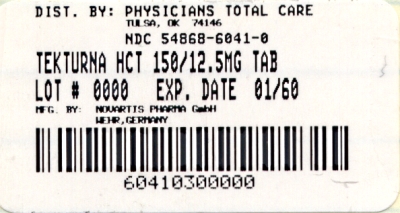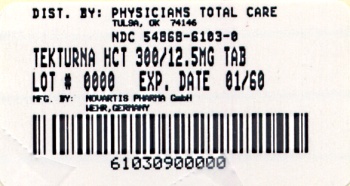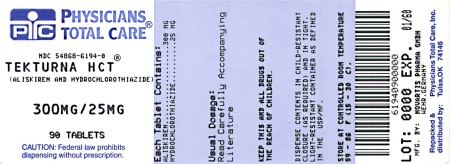FULL PRESCRIBING INFORMATION
WARNING: AVOID USE IN PREGNANCY
When pregnancy is detected, discontinue Tekturna HCT as soon as possible. Drugs that act directly on the renin-angiotensin system can cause injury and death to the developing fetus. [See Warnings and Precautions (5.1)]
1 INDICATIONS AND USAGE
Tekturna HCT is indicated for the treatment of hypertension.
Add-On Therapy
A patient whose blood pressure is not adequately controlled with aliskiren alone or hydrochlorothiazide alone may be switched to combination therapy with Tekturna HCT.
A patient whose blood pressure is controlled with hydrochlorothiazide alone but who experiences hypokalemia may be switched to combination therapy with Tekturna HCT.
A patient who experiences dose-limiting adverse reactions on either component alone may be switched to Tekturna HCT containing a lower dose of that component in combination with the other to achieve similar blood pressure reductions.
Replacement Therapy
Tekturna HCT may be substituted for the titrated components.
Initial Therapy
Tekturna HCT may be used as initial therapy in patients who are likely to need multiple drugs to achieve their blood pressure goals.
The choice of Tekturna HCT as initial therapy should be based on an assessment of potential benefits and risks.
Patients with Stage 2 hypertension are at a relatively high risk for cardiovascular events (such as strokes, heart attacks, and heart failure), kidney failure, and vision problems, so prompt treatment is clinically relevant. The decision to use a combination as initial therapy should be individualized and should be shaped by considerations such as baseline blood pressure, the target goal, and the incremental likelihood of achieving goal with a combination compared to monotherapy. Individual blood pressure goals may vary based upon the patient’s risk.
Data from the high-dose multifactorial study [see Clinical Studies (14)] provides estimates of the probability of reaching a target blood pressure with Tekturna HCT compared to aliskiren or hydrochlorothiazide monotherapy. The figures below provide estimates of the likelihood of achieving systolic or diastolic blood pressure control with Tekturna HCT 300/25 mg, based upon baseline systolic or diastolic blood pressure. The curve of each treatment group was estimated by logistic regression modeling. The estimated likelihood at the right tail of each curve is less reliable because of small numbers of subjects with high baseline blood pressures.
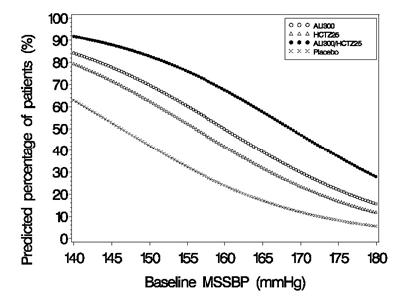
Figure 1: Probability of Achieving Systolic Blood Pressure (SBP) <140 mmHg
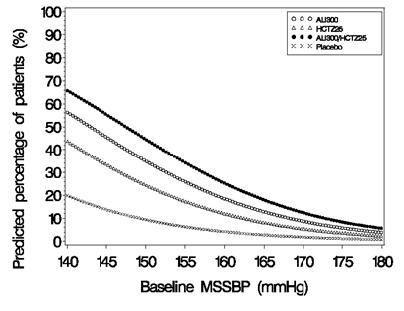
Figure 2: Probability of Achieving Systolic Blood Pressure (SBP) <130 mmHg
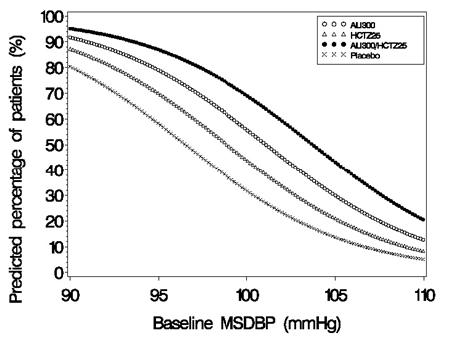
Figure 3: Probability of Achieving Diastolic Blood Pressure (DBP) <90 mmHg
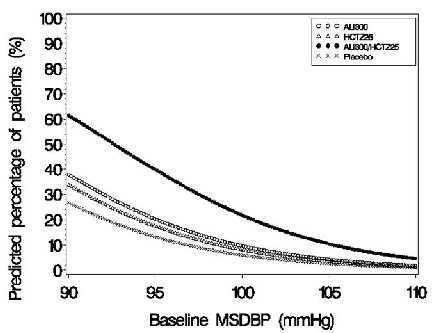
Figure 4: Probability of Achieving Diastolic Blood Pressure (DBP) <80 mmHg
At all levels of baseline blood pressure, the probability of achieving any given diastolic or systolic goal is greater with the combination than for either monotherapy. For example, the mean baseline msSBP/msDBP for patients participating in this multifactorial study was 154/99 mmHg. A patient with a baseline blood pressure of 154/99 mmHg has about a 62% chance of achieving a goal of <140 mmHg (systolic) and 61% chance of achieving <90 mmHg (diastolic) on aliskiren alone, and the chance of achieving these goals on hydrochlorothiazide alone is about 54% (systolic) and 49% (diastolic). The chance of achieving these goals on Tekturna HCT rises to about 77% (systolic) and 74% (diastolic). The chance of achieving these goals on placebo is about 34% (systolic) and 37% (diastolic). [See Dosage and Administration (2) and Clinical Studies (14).]
2 DOSAGE AND ADMINISTRATION
2.1 Dose Selection
The recommended once-daily doses of Tekturna HCT in order of increasing mean effect are 150/12.5 mg, 150/25 mg or 300/12.5 mg, and 300/25 mg.
2.2 Dose Titration
The antihypertensive effect of Tekturna HCT is largely manifested within 1 week, with maximal effects generally seen at around 4 weeks. If blood pressure remains uncontrolled after 2 to 4 weeks of therapy, the dose may be titrated up to a maximum of aliskiren 300 mg/hydrochlorothiazide 25 mg.
2.3 Add-On Therapy
A patient whose blood pressure is not adequately controlled with aliskiren alone or hydrochlorothiazide alone may be switched to combination therapy with Tekturna HCT. The usual recommended starting dose is 150/12.5 mg once daily as needed to control blood pressure. The dose may be titrated up to a maximum of aliskiren 300 mg/hydrochlorothiazide 25 mg once daily.
2.5 Initial Therapy
The usual recommended starting dose is 150/12.5 mg once daily as needed to control blood pressure. The dose may be titrated up to a maximum of aliskiren 300 mg/hydrochlorothiazide 25 mg once daily.
Tekturna HCT is not recommended for use as initial therapy in patients with intravascular volume depletion. [See Warnings and Precautions (5.3)]
2.6 Use with Other Antihypertensive Drugs
Tekturna HCT may be administered with other antihypertensive agents. There are no data available with use of Tekturna HCT with angiotensin-converting enzyme inhibitors or beta blockers [see Clinical Studies (14)].
2.7 Relationship to Meals
Patients should establish a routine pattern for taking Tekturna HCT with regard to meals. High-fat meals decrease absorption substantially [see Clinical Pharmacology (12.3)].
2.8 Dosing in Specific Populations
Renal Impairment
The usual regimens of Tekturna HCT may be followed as long as the patient’s creatinine clearance is >30 mL/min. In patients with more severe renal impairment, loop diuretics are preferred to thiazides, so Tekturna HCT is not recommended.
Hepatic Impairment
Adjustment of the starting dose is not necessary with hepatic impairment.
Elderly Patients
Adjustment of the starting dose is not required for elderly patients.
3 DOSAGE FORMS AND STRENGTHS
- 150 mg/12.5 mg tablets: white, biconvex ovaloid, film-coated tablets imprinted with NVR/LCI
- 150 mg/25 mg tablets: pale yellow, biconvex ovaloid, film-coated tablets imprinted with NVR/CLL
- 300 mg/12.5 mg tablets: violet white, biconvex ovaloid, film-coated tablets imprinted with NVR/CVI
- 300 mg/25 mg tablets: light yellow, biconvex ovaloid, film-coated tablets imprinted with NVR/CVV
4 CONTRAINDICATIONS
Because of the hydrochlorothiazide component, Tekturna HCT is contraindicated in patients with anuria or hypersensitivity to sulfonamide-derived drugs [see Warnings and Precautions (5.6) and Adverse Reactions (6.1)]. Hypersensitivity reactions may range from urticaria to anaphylaxis [see Adverse Reactions (6.1)].
5 WARNINGS AND PRECAUTIONS
5.1 Fetal/Neonatal Morbidity and Mortality
Tekturna HCT can cause fetal harm when administered to a pregnant woman. If this drug is used during pregnancy, or if the patient becomes pregnant while taking this drug, the patient should be apprised of the potential hazard to the fetus.
Drugs that act directly on the renin-angiotensin system can cause fetal and neonatal morbidity and death when administered to pregnant women. If this drug is used during pregnancy, or if the patient becomes pregnant while taking this drug, apprise the patient of the potential hazard to the fetus. [see Use in Specific Populations (8.1)] In several dozen published cases, ACE inhibitors use during the second and third trimesters of pregnancy was associated with fetal and neonatal injury, including hypotension, neonatal skull hypoplasia, anuria, reversible or irreversible renal failure, and death. In addition, first trimester use of ACE inhibitors has been associated with birth defects. Thiazides cross the placenta, and use of thiazides during pregnancy is associated with a risk of fetal or neonatal jaundice, thrombocytopenia, and possible other adverse reactions that have occurred in adults.
5.2 Head and Neck Angioedema
Aliskiren
Angioedema of the face, extremities, lips, tongue, glottis and/or larynx has been reported in patients treated with Tekturna and has necessitated hospitalization and intubation. This may occur at any time during treatment and has occurred in patients with and without a history of angioedema with ACE inhibitors or angiotensin receptor antagonists. If angioedema involves the throat, tongue, glottis or larynx, or if the patient has a history of upper respiratory surgery, airway obstruction may occur and be fatal. Patients who experience these effects, even without respiratory distress, require prolonged observation since treatment with antihistamines and corticosteroids may not be sufficient to prevent respiratory involvement. Prompt administration of subcutaneous epinephrine solution 1:1000 (0.3 to 0.5 ml) and measures to ensure a patient airway may be necessary.
Discontinue Tekturna immediately in patients who develop angioedema, and do not readminister.
5.3 Hypotension in Volume- and/or Salt-Depleted Patients
An excessive fall in blood pressure (hypotension) was rarely seen (<1%) in patients with uncomplicated hypertension treated with Tekturna HCT in controlled trials. In patients with an activated renin-angiotensin system, such as volume- and/or salt-depleted patients receiving high doses of diuretics, symptomatic hypotension may occur. Correct these conditions prior to administration of Tekturna HCT, or the treatment should start under close medical supervision.
If an excessive fall in blood pressure occurs, place the patient in the supine position and, if necessary, given an intravenous infusion of normal saline. A transient hypotensive response is not a contraindication to further treatment, which usually can be continued without difficulty once the blood pressure has stabilized.
5.4 Patients with Severe Renal Impairment
Tekturna HCT
In patients with severe renal impairment (GFR <30 mL/min), loop diuretics are preferred to thiazides, so Tekturna HCT is not recommended.
Hydrochlorothiazide
Uptitrate slowly;in patients with renal disease, thiazides may precipitate azotemia. Cumulative effects of the drug may develop in patients with impaired renal function.
5.5 Patients with Hepatic Impairment
Hydrochlorothiazide
Uptitrate slowly; minor alterations of fluid and electrolyte balance may precipitate hepatic coma.
5.6 Hypersensitivity Reactions
Hydrochlorothiazide
Hypersensitivity reactions to hydrochlorothiazide may occur in patients with or without a history of allergy or bronchial asthma, but are more likely in patients with such a history.
5.7 Systemic Lupus Erythematosus
Hydrochlorothiazide
Thiazide diuretics have been reported to cause exacerbation or activation of systemic lupus erythematosus.
5.8 Lithium Interaction
Hydrochlorothiazide
Lithium generally should not be given with thiazides [see Drug Interaction (7)].
5.9 Serum Electrolyte Abnormalities
Tekturna HCT
In the short-term controlled trials of various doses of Tekturna HCT the incidence of hypertensive patients who developed hypokalemia (serum potassium <3.5 mEq/L) was 2.2%; the incidence of hyperkalemia (serum potassium >5.5 mEq/L) was 0.8%. No patients discontinued due to increase or decrease of serum potassium.
Periodic determinations of serum electrolytes to detect possible electrolyte imbalance should be performed at appropriate intervals. The intervals should be based on the history of electrolyte abnormalities in patients with aliskiren or hydrochlorothiazide monotherapy.
Based on experience with the use of other substances that affect the renin-angiotensin system (RAS), concomitant use of Tekturna HCT with potassium-sparing diuretics, potassium supplements, salt substitutes containing potassium, or other drugs that increase potassium levels may lead to increases in serum potassium.
6 ADVERSE REACTIONS
6.1 Clinical Studies Experience
The following serious adverse reactions are discussed in greater detail in other sections of the label:
- Risk of fetal/neonatal morbidity and mortality [see Warnings and Precautions (5.1)]
- Head and neck angioedema [see Warnings and Precautions (5.2)]
- Hypotension in volume- and/or salt-depleted patients [see Warnings and Precautions (5.3)]
Because clinical trials are conducted under widely varying conditions, adverse reaction rates observed in the clinical trials of a drug cannot be directly compared to rates in clinical trials of another drug and may not reflect the rates observed in practice.
Tekturna HCT
Tekturna HCT has been evaluated for safety in more than 2,700 patients, including over 700 treated for 6 months and 190 for over 1 year. In placebo-controlled clinical trials, discontinuation of therapy due to a clinical adverse event (including uncontrolled hypertension) occurred in 2.7% of patients treated with Tekturna HCT versus 3.6% of patients given placebo.
Adverse events in placebo-controlled trials that occurred in at least 1% of patients treated with Tekturna HCT and at a higher incidence than placebo included dizziness (2.3% vs. 1%), influenza (2.3% vs. 1.6%), diarrhea (1.6% vs. 0.5%), cough (1.3% vs. 0.5%), vertigo (1.2% vs. 0.5%), asthenia (1.2% vs. 0%), and arthralgia (1% vs. 0.5%).
Aliskiren
Aliskiren has been evaluated for safety in 6,460 patients, including 1,740 treated for longer than 6 months, and 1,250 for longer than 1 year. In placebo-controlled clinical trials, discontinuation of therapy due to a clinical adverse event, including uncontrolled hypertension occurred in 2.2% of patients treated with aliskiren, versus 3.5% of patients given placebo.
Two cases of angioedema with respiratory symptoms were reported with aliskiren use in the clinical studies. Two other cases of periorbital edema without respiratory symptoms were reported as possible angioedema and resulted in discontinuation. The rate of these angioedema cases in the completed studies was 0.06%.
In addition, 26 other cases of edema involving the face, hands, or whole body were reported with aliskiren use, including 4 leading to discontinuation.
In the placebo-controlled studies, however, the incidence of edema involving the face, hands, or whole body was 0.4% with aliskiren compared with 0.5% with placebo. In a long-term active-controlled study with aliskiren and HCTZ arms, the incidence of edema involving the face, hands, or whole body was 0.4% in both treatment arms.
Aliskiren produces dose-related gastrointestinal (GI) adverse reactions. Diarrhea was reported by 2.3% of patients at 300 mg, compared to 1.2% in placebo patients. In women and the elderly (age ≥65) increases in diarrhea rates were evident starting at a dose of 150 mg daily, with rates for these subgroups at 150 mg comparable to those seen at 300 mg for men or younger patients (all rates about 2% to 2.3%). Other GI symptoms included abdominal pain, dyspepsia, and gastroesophageal reflux, although increased rates for abdominal pain and dyspepsia were distinguished from placebo only at 600 mg daily. Diarrhea and other GI symptoms were typically mild and rarely led to discontinuation.
Aliskiren was associated with a slight increase in cough in the placebo-controlled studies (1.1% for any aliskiren use vs. 0.6% for placebo). In active-controlled trials with ACE inhibitor (ramipril, lisinopril) arms, the rates of cough for the aliskiren arms were about one-third to one-half the rates in the ACE inhibitor arms.
Other adverse reactions with increased rates for aliskiren compared to placebo included rash (1% vs. 0.3%), elevated uric acid (0.4% vs. 0.1%), gout (0.2% vs. 0.1%), and renal stones (0.2% vs. 0%).
Single episodes of tonic-clonic seizures with loss of consciousness were reported in two patients treated with aliskiren in the clinical trials. One patient had predisposing causes for seizures and had a negative electroencephalogram (EEG) and cerebral imaging following the seizures; for the other patient, EEG and imaging results were not reported. Aliskiren was discontinued and there was no rechallenge in either case.
The following adverse events occurred in placebo-controlled clinical trials at an incidence of more than 1% of patients treated with aliskiren, but also occurred at about the same or greater incidence in patients receiving placebo: headache, nasopharyngitis, dizziness, fatigue, upper respiratory tract infection, back pain and cough.
No clinically meaningful changes in vital signs or in ECG (including QTc interval) were observed in patients treated with aliskiren.
Hydrochlorothiazide
Other adverse reactions that have been reported with hydrochlorothiazide, without regard to causality, are listed below:
Body As A Whole: weakness
Digestive: pancreatitis, jaundice (intrahepatic cholestatic jaundice), sialadenitis, cramping, gastric irritation
Hematologic: aplastic anemia, agranulocytosis, leukopenia, hemolytic anemia, thrombocytopenia;
Hypersensitivity: purpura, photosensitivity, urticaria, necrotizing angiitis (vasculitis and cutaneous vasculitis), fever, respiratory distress including pneumonitis and pulmonary edema, anaphylactic reactions
Metabolic: hyperglycemia, glycosuria, hyperuricemia
Musculoskeletal: muscle spasm
Nervous System/Psychiatric: restlessness
Renal: renal failure, renal dysfunction, interstitial nephritis
Skin: erythema multiforme including Stevens-Johnson syndrome, exfoliative dermatitis including toxic epidermal necrolysis
Special Senses: transient blurred vision, xanthopsia
6.2 Clinical Laboratory Test Abnormalities
In controlled clinical trials, clinically important changes in standard laboratory parameters were rarely associated with administration of Tekturna HCT.
Blood Urea Nitrogen (BUN)/Creatinine: Elevations (greater than 50% increase) in BUN and creatinine occurred in 11.8% and 0.9%, respectively, of patients taking Tekturna HCT, and 7% and 1.1%, respectively, of patients given placebo in short-term controlled clinical trials. No patients were discontinued due to an increase in either BUN or creatinine.
Hemoglobin and Hematocrit: A greater than 20% decrease in hemoglobin and hematocrit were observed in <0.1% and 0.1%, respectively, of patients treated with Tekturna HCT, compared with 0% in placebo-treated patients. No patients were discontinued due to anemia.
Liver Function Tests: Occasional elevations (greater than 150%) in ALT (SGPT) were observed in 1.2% of patients treated with Tekturna HCT, compared with 0% in placebo-treated patients. No patients were discontinued due to abnormal liver function tests.
Serum Uric Acid: Uric acid related abnormalities were more commonly observed in patients treated with Tekturna HCT, compared with placebo; 2.2% versus 0% had a uric acid increase >50% from baseline; gout and renal stones were less commonly observed.
Serum Electrolytes: [See Warnings and Precautions (5.8).]
6.3 Post-Marketing Experience
The following adverse reactions have been reported in aliskiren post-marketing experience. Because these reactions are reported voluntarily from a population of uncertain size, it is not always possible to reliably estimate their frequency or establish a causal relationship to drug exposure.
Hypersensitivity: angioedema requiring airway management and hospitalization
Peripheral edema
7 DRUG INTERACTIONS
No drug interaction studies have been conducted with Tekturna HCT and other drugs, although studies with the individual aliskiren and hydrochlorothiazide components are described below.
Aliskiren
Effects of Other Drugs on Aliskiren
Based on in vitro studies, aliskiren is metabolized by CYP 3A4.
Irbesartan: Coadministration of irbesartan reduced aliskiren Cmax up to 50% after multiple dosing.
P-glycoprotein Effects: Pgp (MDR1/Mdr1a/1b) was found to be the major efflux system involved in absorption and disposition of aliskiren in preclinical studies. The potential for drug interactions at the Pgp site will likely depend on the degree of inhibition of this transporter. Coadministration of aliskiren with Pgp substrates or weak to moderate inhibitors such as atenolol, digoxin, and amlodipine did not result in clinically relevant interactions.
Atorvastatin: Coadministration of atorvastatin, a weak Pgp inhibitor, resulted in about a 50% increase in aliskiren Cmax and AUC after multiple dosing.
Ketoconazole: Coadministration of 200 mg twice-daily ketoconazole, a moderate Pgp inhibitor, with aliskiren resulted in an approximate 80% increase in plasma levels of aliskiren. A 400-mg once-daily dose was not studied but would be expected to increase aliskiren blood levels further.
Cyclosporine: Coadministration of 200 mg and 600 mg cyclosporine, a potent Pgp inhibitor, with 75 mg aliskiren resulted in an approximately 2.5-fold increase in Cmax and 5-fold increase in AUC of aliskiren. Concomitant use of aliskiren with cyclosporine is not recommended.
Verapamil: Coadministration of 240 mg of verapamil, a moderate Pgp inhibitor, with 300 mg aliskiren resulted in an approximately 2-fold increase in Cmax and AUC of aliskiren. However, no dosage adjustment is necessary.
Drugs with no clinically significant effects: Coadministration of lovastatin, atenolol, warfarin, furosemide, digoxin, celecoxib, hydrochlorothiazide, ramipril, valsartan, metformin and amlodipine did not result in clinically significant increases in aliskiren exposure.
Effects of Aliskiren on Other Drugs
Aliskiren does not inhibit the CYP450 isoenzymes (CYP1A2, 2C8, 2C9, 2C19, 2D6, 2E1, and CYP 3A) or induce CYP 3A4.
Furosemide: When aliskiren was coadministered with furosemide, the AUC and Cmax of furosemide were reduced by about 30% and 50%, respectively. Patients receiving furosemide could find its effect diminished after starting aliskiren.
Drugs with no clinically significant effects: Coadministration of aliskiren did not significantly affect the pharmacokinetics of lovastatin, digoxin, valsartan, amlodipine, metformin, celecoxib, atenolol, atorvastatin, ramipril or hydrochlorothiazide.
Warfarin: The effects of aliskiren on warfarin pharmacokinetics have not been evaluated.
Hydrochlorothiazide
When administered concurrently, the following drugs may interact with thiazide diuretics.
Alcohol, barbiturates, or narcotics: Potentiation of orthostatic hypotension may occur.
Antidiabetic drugs (oral agents and insulin): Dosage adjustment of the antidiabetic drug may be required.
Other antihypertensive drugs: Additive effect or potentiation.
Cholestyramine and colestipol resins: Absorption of hydrochlorothiazide is impaired in the presence of anionic exchange resins. Single doses of either cholestyramine or colestipol resins bind the hydrochlorothiazide and reduce its absorption from the gastrointestinal tract by up to 85% and 43%, respectively.
Corticosteroids, ACTH: Intensified electrolyte depletion, particularly hypokalemia.
Pressor amines (e.g., norepinephrine): Possible decreased response to pressor amines but not sufficient to preclude their use.
Skeletal muscle relaxants, nondepolarizing (e.g., tubocurarine): Possible increased responsiveness to the muscle relaxants.
Lithium: Should not generally be given with diuretics. Diuretic agents reduce the renal clearance of lithium and increase the risk of lithium toxicity. Refer to the package insert for lithium before use of such preparation with Tekturna HCT.
Nonsteroidal anti-inflammatory drugs: In some patients, the administration of a nonsteroidal anti-inflammatory agent can reduce the diuretic, natriuretic, and antihypertensive effects of loop, potassium-sparing and thiazide diuretics. Therefore, when Tekturna HCT and nonsteroidal anti-inflammatory agents are used concomitantly, the patient should be observed closely to determine if the desired effect of the diuretic is obtained.
8 USE IN SPECIFIC POPULATIONS
8.1 Pregnancy
Pregnancy Category D [See Warnings and Precautions (5.1).]
Tekturna HCT contains both aliskiren (a direct renin inhibitor) and hydrochlorothiazide (a thiazide diuretic). When administered during the second or third trimester of pregnancy, drugs that act directly on the renin-angiotensin system can cause fetal and neonatal morbidity and death.
Thiazides can cross the placenta, and use of thiazides during pregnancy is associated with a risk of fetal or neonatal jaundice, thrombocytopenia, and possibly other adverse reactions that have occurred in adults. Tekturna HCT can cause fetal harm when administered to a pregnant woman. If this drug is used during pregnancy, or if the patient becomes pregnant while taking this drug, apprise the patient of the potential hazard to the fetus.
In several dozen published cases, ACE inhibitor use during the second and third trimesters of pregnancy was associated with fetal and neonatal injury, including hypotension, neonatal skull hypoplasia, anuria, reversible or irreversible renal failure, and death. Oligohydramnios was also reported, presumably from decreased fetal renal function. In this setting, oligohydramnios was associated with fetal limb contractures, craniofacial deformation, and hypoplastic lung development. Prematurity, intrauterine growth retardation, and patent ductus arteriosus were also reported, although it is not clear whether these occurrences were due to exposure to the drug. In addition, first trimester use of ACE inhibitors, a specific class of drugs acting on the renin-angiotensin system, has been associated with a potential risk of birth defects in retrospective data.
When pregnancy occurs in a patient using Tekturna HCT, the physician should discontinue Tekturna HCT treatment as soon as possible. The physician should inform the patient about potential risks to the fetus based on the time of gestational exposure to Tekturna HCT (first trimester only or later). If exposure occurs beyond the first trimester, an ultrasound examination should be done.
In rare cases when another antihypertensive agent cannot be used to treat the pregnant patient, serial ultrasound examinations should be performed to assess the intraamniotic environment. Routine fetal testing with non-stress tests, biophysical profiles, and/or contraction stress tests may be appropriate based on gestational age and standards of care in the community. If oligohydramnios occurs in these situations, individualized decisions about continuing or discontinuing Tekturna HCT treatment and about pregnancy management should be made by the patient, her physician, and experts in the management of high risk pregnancy. Patients and physicians should be aware that oligohydramnios may not appear until after the fetus has sustained irreversible injury. Infants with histories of in utero exposure to Tekturna HCT should be closely observed for hypotension, oliguria, and hyperkalemia. If oliguria occurs, these infants may require blood pressure and renal perfusion support. Exchange transfusion or dialysis may be required to reverse hypotension and/or support decreased renal function.
No reproductive toxicity studies have been conducted with the combination of aliskiren and hydrochlorothiazide. However, these studies have been conducted for aliskiren as well as hydrochlorothiazide alone.
Reproductive toxicity studies of aliskiren hemifumarate did not reveal any evidence of teratogenicity at oral doses up to 600 mg aliskiren/kg/day (20 times the maximum recommended human dose [MRHD] of 300 mg/day on a mg/m2 basis) in pregnant rats or up to 100 mg aliskiren/kg/day (seven times the MRHD on a mg/m2 basis) in pregnant rabbits. Fetal birth weight was adversely affected in rabbits at 50 mg/kg/day (3.2 times the MRHD on a mg/m2 basis). Aliskiren was present in placenta, amniotic fluid and fetuses of pregnant rabbits.
When pregnant mice and rats were given hydrochlorothiazide at doses up to 3000 and 1000 mg/kg/day, respectively (about 600 and 400 times the MRHD) during their respective periods of major organogenesis, there was no evidence of fetal harm.
8.3 Nursing Mothers
It is not known whether aliskiren is excreted in human milk, but aliskiren was secreted in the milk of lactating rats. Thiazides appear in human milk. Because of the potential for adverse effects on the nursing infant, a decision should be made whether to discontinue nursing or discontinue the drug, taking into account the importance of the drug to the mother.
8.5 Geriatric Use
In the short-term controlled clinical trials of Tekturna HCT, 325 (19.6%) patients treated with Tekturna HCT were ≥65 years and 53 (3.2%) were ≥75 years.
No overall differences in safety or effectiveness were observed between these subjects and younger subjects, and other reported clinical experience has not identified differences in responses between the elderly and younger patients, but greater sensitivity of some older individuals cannot be ruled out.
10 OVERDOSAGE
Aliskiren
Limited data are available related to overdosage in humans. The most likely manifestation of overdosage would be hypotension. If symptomatic hypotension should occur, supportive treatment should be initiated.
Hydrochlorothiazide
The most common signs and symptoms of overdose observed in humans are those caused by electrolyte depletion (hypokalemia, hypochloremia, hyponatremia) and dehydration resulting from excessive diuresis. If digitalis has also been administered, hypokalemia may accentuate cardiac arrhythmias. The degree to which hydrochlorothiazide is removed by hemodialysis has not been established. The oral LD50 of hydrochlorothiazide is greater than 10 g/kg in both mice and rats.
11 DESCRIPTION
Tekturna HCT is a fixed combination of aliskiren, an orally active, nonpeptide, direct renin inhibitor, and hydrochlorothiazide, a thiazide diuretic.
Aliskiren
Aliskiren hemifumarate is chemically described as (2S,4S,5S,7S)-N-(2-Carbamoyl-2-methylpropyl)-5-amino-4-hydroxy-2,7-diisopropyl-8-[4-methoxy-3-(3-methoxypropoxy)phenyl]-octanamide hemifumarate and its structural formula is
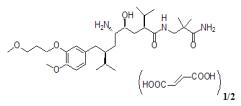
Molecular formula: C30H53N3O6 • 0.5 C4H4O4
Aliskiren hemifumarate is a white to slightly yellowish crystalline powder with a molecular weight of 609.8 (free base- 551.8). It is soluble in phosphate buffer, n-Octanol, and highly soluble in water.
Hydrochlorothiazide
Hydrochlorothiazide USP is a white, or practically white, practically odorless, crystalline powder. It is slightly soluble in water; freely soluble in sodium hydroxide solution, in n-butylamine, and in dimethylformamide; sparingly soluble in methanol; and insoluble in ether, in chloroform, and in dilute mineral acids. Hydrochlorothiazide is chemically described as 6-chloro-3,4-dihydro-2H-1,2,4-benzothiadiazine-7-sulfonamide 1,1-dioxide.
Hydrochlorothiazide is a thiazide diuretic. Its empirical formula is C7H8ClN3O4S2, its molecular weight is 297.73, and its structural formula is
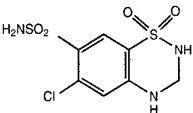
Tekturna HCT tablets are formulated for oral administration to contain aliskiren and hydrochlorothiazide, USP 150/12.5 mg, 150/25 mg, 300/12.5 mg and 300/25 mg. The inactive ingredients for all strengths of the tablets are colloidal silicon dioxide, crospovidone, hydroxypropyl methylcellulose, iron oxide colorants, lactose, magnesium stearate, microcrystalline cellulose, polyethylene glycol, povidone, talc, titanium dioxide, and wheat starch.
12 CLINICAL PHARMACOLOGY
12.1 Mechanism of Action
Aliskiren
Renin is secreted by the kidney in response to decreases in blood volume and renal perfusion. Renin cleaves angiotensinogen to form the inactive decapeptide angiotensin I (Ang I). Ang I is converted to the active octapeptide angiotensin II (Ang II) by angiotensin-converting enzyme (ACE) and non-ACE pathways. Ang II is a powerful vasoconstrictor and leads to the release of catecholamines from the adrenal medulla and prejunctional nerve endings. It also promotes aldosterone secretion and sodium reabsorption. Together, these effects increase blood pressure. Ang II also inhibits renin release, thus providing a negative feedback to the system. This cycle, from renin through angiotensin to aldosterone and its associated negative feedback loop, is known as the renin-angiotensin-aldosterone system (RAAS). Aliskiren is a direct renin inhibitor, decreasing plasma renin activity (PRA) and inhibiting the conversion of angiotensinogen to Ang I. Whether aliskiren affects other RAAS components, e.g., ACE or non-ACE pathways, is not known.
All agents that inhibit the RAAS, including renin inhibitors, suppress the negative feedback loop, leading to a compensatory rise in plasma renin concentration. When this rise occurs during treatment with ACE inhibitors and ARBs, the result is increased levels of PRA. During treatment with aliskiren, however, the effect of increased renin levels is blocked, so that PRA, Ang I and Ang II are all reduced, whether aliskiren is used as monotherapy or in combination with other antihypertensive agents.
Hydrochlorothiazide
Hydrochlorothiazide is a thiazide diuretic. Thiazides affect the renal tubular mechanisms of electrolyte reabsorption, directly increasing excretion of sodium and chloride in approximately equivalent amounts. Indirectly, the diuretic action of hydrochlorothiazide reduces plasma volume, with consequent increases in plasma renin activity, increases in aldosterone secretion, increases in urinary potassium loss, and decreases in serum potassium. The renin-aldosterone link is mediated by angiotensin II, so coadministration of agents that block the production or function of angiotensin II tends to reverse the potassium loss associated with these diuretics.
The mechanism of action of the antihypertensive effect of thiazides is unknown.
12.2 Pharmacodynamics
Tekturna HCT
In placebo-controlled clinical trials, PRA was decreased with aliskiren monotherapy (ranging from 54% to 65%) and increased with hydrochlorothiazide monotherapy (ranging from 4% to 72%). Treatment with Tekturna HCT resulted in PRA reductions ranging from approximately 46% to 63% in various doses despite the increase in PRA with hydrochlorothiazide treatment. The clinical implications of the differences in effect on PRA are not known.
Aliskiren
PRA reductions in clinical trials ranged from approximately 50% to 80%, were not dose-related and did not correlate with blood pressure reductions. The clinical implications of the differences in effect on PRA are not known.
Hydrochlorothiazide
After oral administration of hydrochlorothiazide, diuresis begins within 2 hours, peaks in about 4 hours, and lasts about 6 to 12 hours.
12.3 Pharmacokinetics
Absorption and Distribution
Tekturna HCT
Following oral administration of Tekturna HCT combination tablets, the median peak plasma concentration time are within 1 hour for aliskiren and 2.5 hours for hydrochlorothiazide. When taken with food, mean AUC and Cmax of aliskiren are decreased by 60% and 82%, respectively; mean AUC and Cmax of hydrochlorothiazide increased by 13% and 10%, respectively. As a result, patients should establish a routine pattern for taking Tekturna HCT with regard to meals and should be advised that high-fat meals decrease absorption of aliskiren substantially.
Hydrochlorothiazide
Hydrochlorothiazide crosses the placental but not the blood-brain barrier and is excreted in breast milk.
Metabolism and Elimination
Aliskiren
About one-fourth of the absorbed dose appears in the urine as parent drug. How much of the absorbed dose is metabolized is unknown. Based on the in vitro studies, the major enzyme responsible for aliskiren metabolism appears to be CYP 3A4.
Hydrochlorothiazide
Hydrochlorothiazide is not metabolized but is eliminated rapidly by the kidney. At least 61% of the oral dose is eliminated as unchanged drug within 24 hours. The elimination half-life is between 5.8 and 18.9 hours.
Special Populations
Pediatric Patients
The pharmacokinetics of aliskiren have not been investigated in patients <18 years of age.
Geriatric Patients
The pharmacokinetics of aliskiren were studied in the elderly (≥65 years). Exposure (measured by AUC) is increased in elderly patients. Adjustment of the starting dose is not required in these patients [see Dosage and Administration (2)].
Race
Too few non-Caucasians have been studied with Tekturna HCT to assess pharmacokinetic differences among races. The pharmacokinetic differences among Blacks, Caucasians, and Japanese are minimal with aliskiren therapy.
Renal Impairment
The pharmacokinetics of aliskiren were evaluated in patients with varying degrees of renal impairment. Rate and extent of exposure (AUC and Cmax) of aliskiren in subjects with renal impairment did not show a consistent correlation with the severity of renal impairment. Adjustment of the starting dose is not required in patients with mild or moderate renal impairment, but Tekturna HCT is not recommended in patients with severe renal impairment [see Dosage and Administration (2) and Warnings and Precautions (5.4)].
Hepatic Impairment
The pharmacokinetics of aliskiren were not significantly affected in patients with mild-to-severe liver disease. Consequently, adjustment of the starting dose is not required in these patients [see Dosage and Administration (2)].
13 NONCLINICAL TOXICOLOGY
13.1 Carcinogenesis, Mutagenesis, Impairment of Fertility
Tekturna HCT
No carcinogenicity, mutagenicity or fertility studies have been conducted with Tekturna HCT. However, these studies have been conducted for aliskiren as well as hydrochlorothiazide alone.
Aliskiren
Carcinogenic potential was assessed in a 2-year rat study and a 6-month transgenic (rasH2) mouse study with aliskiren hemifumarate at oral doses of up to 1500 mg aliskiren/kg/day. Although there were no statistically significant increases in tumor incidence associated with exposure to aliskiren, mucosal epithelial hyperplasia (with or without erosion/ulceration) was observed in the lower gastrointestinal tract at doses of 750 or more mg/kg/day in both species, with a colonic adenoma identified in one rat and a cecal adenocarcinoma identified in another, rare tumors in the strain of rat studied. On a systemic exposure (AUC0-24hr) basis, 1500 mg/kg/day in the rat is about 4 times and in the mouse about 1.5 times the maximum recommended human dose (300 mg aliskiren/day). Mucosal hyperplasia in the cecum or colon of rats was also observed at doses of 250 mg/kg/day (the lowest tested dose) as well as at higher doses in 4- and 13-week studies.
Aliskiren hemifumarate was devoid of genotoxic potential in the Ames reverse mutation assay with S. typhimurium and E. coli, the in vitro Chinese hamster ovary cell chromosomal aberration assay, the in vitro Chinese hamster V79 cell gene mutation test and the in vivo mouse bone marrow micronucleus assay.
Fertility of male and female rats was unaffected at doses of up to 250 mg aliskiren/kg/day (8 times the maximum recommended human dose of 300 mg Tekturna/60 kg on a mg/m2 basis.
Hydrochlorothiazide
Two-year feeding studies in mice and rats conducted under the auspices of the National Toxicology Program (NTP) uncovered no evidence of a carcinogenic potential of hydrochlorothiazide in female mice (at doses of up to approximately 600 mg/kg/day) or in male and female rats (at doses of up to approximately 100 mg/kg/day). The NTP, however, found equivocal evidence for hepatocarcinogenicity in male mice.
Hydrochlorothiazide was not genotoxic in vitro in the Ames mutagenicity assay of S. typhimurium strains TA 98, TA 100, TA 1535, TA 1537, and TA 1538 and in the Chinese Hamster Ovary (CHO) test for chromosomal aberrations, or in vivo in assays using mouse germinal cell chromosomes, Chinese hamster bone marrow chromosomes, and the Drosophila sex-linked recessive lethal trait gene. Positive test results were obtained only in the in vitro CHO Sister Chromatid Exchange (clastogenicity) and in the Mouse Lymphoma Cell (mutagenicity) assays, using concentrations of hydrochlorothiazide from 43 to 1300 mcgm/mL, and in the Aspergillums Nidulans nondisjunction assay at an unspecified concentration.
Hydrochlorothiazide had no adverse effects on the fertility of mice and rats of either sex in studies wherein these species were exposed, via their diet, to doses of up to 100 and 4 mg/kg, respectively, prior to mating and throughout gestation. These doses of hydrochlorothiazide in mice and rats represent 19 and 1.5 times, respectively, the maximum recommended human dose on a mg/m2 basis. (Calculations assume an oral dose of 25 mg/day and a 60-kg patient.)
14 CLINICAL STUDIES
Tekturna HCT
In all clinical trials including over 6,200 patients, more than 2,700 patients were exposed to combinations of aliskiren and hydrochlorothiazide. The safety and efficacy of Tekturna HCT were evaluated in patients with mild-to-moderate hypertension in an 8-week, randomized, double-blind, placebo-controlled, parallel-group, 15-arm factorial trial (n=2762). Patients were randomized to receive various combinations of aliskiren (75 mg to 300 mg) plus hydrochlorothiazide (6.25 mg to 25 mg) once daily (without titrating up from monotherapy) and followed for blood pressure response. The combination of aliskiren and hydrochlorothiazide resulted in additive placebo-adjusted decreases in systolic and diastolic blood pressure at trough of 10-14/5-7 mmHg at doses of 150-300 mg/12.5-25 mg, compared to 5-8/2-3 mmHg for aliskiren 150 mg to 300 mg and 6-7/2-3 mmHg for hydrochlorothiazide 12.5 mg to 25 mg, alone. Blood pressure reductions with the combinations were greater than the reductions with the monotherapies as shown in Table 1.
| Hydrochlorothiazide, mg | |||||
| 0 | 6.25 | 12.5 | 25 | ||
| Aliskiren, mg | Placebo Mean Change | Placebo-subtracted | Placebo-subtracted | Placebo-subtracted | Placebo-subtracted |
| 0 | 7.5/6.9 | -- | 3.5/2.1 | 6.4/3.2 | 6.8/2.4 |
| 75 | -- | 1.9/1.8 | 6.8/3.8 | 8.2/4.2 | 9.8/4.5 |
| 150 | -- | 4.8/2 | 7.8/3.4 | 10.1/5 | 12/5.7 |
| 300 | -- | 8.3/3.3 | -- | 12.3/7 | 13.7/7.3 |
The safety and efficacy of Tekturna HCT as initial therapy was evaluated in this trial. All patients randomized to the combination groups received the combination treatment of Tekturna HCT at assigned doses as initial therapy without titration from monotherapy. The figures [see Indications and Usage (1)] display the probability that a patient will achieve systolic or diastolic blood pressure goal with Tekturna HCT 300/25 mg, based upon their baseline systolic or diastolic blood pressure. At all levels of baseline blood pressure, the probability of achieving any given diastolic or systolic goal is greater with the combination than for either monotherapy..
The antihypertensive effect of Tekturna HCT was largely manifested within 1 week. The maximum antihypertensive effect was generally attained after about 4 weeks of therapy.
One active-controlled trial investigated the addition of 300 mg aliskiren in obese hypertensive patients who did not respond adequately to hydrochlorothiazide 25 mg, and showed incremental decreases of systolic and diastolic blood pressure of approximately 7/4 mmHg.
In long-term follow-up studies (without placebo control) the effect of the combination of aliskiren and hydrochlorothiazide was maintained for over 1 year.
The antihypertensive effect was independent of age and gender. There were too few non-Caucasians to assess differences in blood pressure effects by race.
Aliskiren Monotherapy
The antihypertensive effects of aliskiren have been demonstrated in six randomized, double-blind, placebo-controlled, 8-week clinical trials in patients with mild-to-moderate hypertension. The placebo response and placebo-subtracted changes from baseline in seated trough cuff blood pressure are shown in Table 2.
| Aliskiren Daily Dose, mg | |||||
| 75 | 150 | 300 | 600 | ||
| Study | Placebo Mean Change | Placebo-subtracted | Placebo-subtracted | Placebo-subtracted | Placebo-subtracted |
| 1 | 2.9/3.3 | 5.7/4* | 5.9/4.5* | 11.2/7.5* | -- |
| 2 | 5.3/6.3 | -- | 6.1/2.9* | 10.5/5.4* | 10.4/5.2* |
| 3 | 10/8.6 | 2.2/1.7 | 2.1/1.7 | 5.1/3.7* | -- |
| 4 | 7.5/6.9 | 1.9/1.8 | 4.8/2* | 8.3/3.3* | -- |
| 5 | 3.8/4.9 | -- | 9.3/5.4* | 10.9/6.2* | 12.1/7.6* |
| 6 | 4.6/4.1 | -- | -- | 8.4/4.9† | -- |
| *p<0.05 vs. placebo by ANCOVA with Dunnett’s procedure for multiple comparisons. †p<0.05 vs. placebo by ANCOVA for the pairwise comparison. |
|||||
The studies included approximately 2,730 patients given doses of 75 mg to 600 mg of aliskiren and 1,231 patients given placebo. As shown in Table 2, there is some increase in response with administered dose in all studies, with reasonable effects seen at 150 mg to 300 mg, and no clear further increase at 600 mg. A substantial proportion (85% to 90%) of the blood pressure lowering effect was observed within 2 weeks of treatment. Studies with ambulatory blood pressure monitoring showed reasonable control throughout the interdosing interval, e.g., the ratios of mean daytime to mean nighttime ambulatory BP ranged from 0.6 to 0.9.
Patients in the placebo-controlled trials continued open-label aliskiren for up to one year. A persistent blood pressure lowering effect was demonstrated by a randomized withdrawal study (patients randomized to continued drug or placebo), which showed a statistically significant difference between patients kept on aliskiren and those randomized to placebo. With cessation of treatment, blood pressure gradually returned toward baseline levels over a period of several weeks. There was no evidence of rebound hypertension after abrupt cessation of therapy.
The effectiveness of aliskiren was demonstrated across all demographic subgroups, although Black patients tended to have smaller reductions in blood pressure than Caucasians and Asians, as has been seen with ACE inhibitors and ARBs.
Aliskiren in Combination with Other Antihypertensives
Valsartan
Aliskiren 150 mg and 300 mg and valsartan 160 mg and 320 mg were studied alone and in combination in an 8-week, 1,797-patient, randomized, double-blind, placebo-controlled, parallel-group, 4-arm, dose-escalation study. The dosages of aliskiren and valsartan were started at 150 mg and 160 mg, respectively, and increased at four weeks to 300 mg and 320 mg, respectively. Seated trough cuff blood pressure was measured at baseline, 4, and 8 weeks. Blood pressure reductions with the combinations were greater than the reductions with the monotherapies as shown in Table 3.
| Valsartan, mg | ||||
| Aliskiren, mg | Placebo Mean Change | 0 | 160 | 320 |
| 0 | 4.6/4.1* | -- | 5.6/3.9 | 8.2/5.6 |
| 150 | -- | 5.4/2.7 | 10.0/5.7 | -- |
| 300 | -- | 8.4/4.9 | -- | 12.6/8.1 |
| * The placebo change is 5.2/4.8 for Week 4 endpoint which was used for the dose groups containing aliskiren 150 mg or valsartan 160 mg. | ||||
ACE Inhibitors and Amlodipine
Aliskiren has not been studied when added to maximal doses of ACE inhibitors to determine whether aliskiren produces additional blood pressure reduction with a maximal dose of an ACE inhibitor. Aliskiren 150 mg provided additional blood pressure reduction when coadministered with amlodipine 5 mg in one study, but the combination was not statistically significantly better than amlodipine 10 mg.
16 HOW SUPPLIED/STORAGE AND HANDLING
Tekturna HCT is supplied as biconvex, ovaloid film-coated tablets.
All strengths are packaged in bottles as described below.
| Tablet | Color | Imprint | Imprint | NDC # | ||
| Aliskiren/HCTZ |
| Side 1 | Side 2 | Bottle of 30 | Bottle of 90 | |
| 150 mg/12.5 mg | White | NVR | LCI | 54868-6041-0 | -- |
|
| 300 mg/12.5 mg | Violet White | NVR | CVI | -- | 54868-6103-0 |
|
| 300 mg/25 mg | Light Yellow | NVR | CVV | -- | 54868-6194-0 |
|
Storage
Store at 25ºC (77ºF); excursions permitted to 15-30ºC (59-86ºF) [see USP Controlled Room Temperature].
Protect from moisture.
Dispense in tight container (USP).
17 PATIENT COUNSELING INFORMATION
Healthcare professionals should instruct their patients to read the Patient Package Insert before starting Tekturna HCT and to reread each time the prescription is renewed. Patients should be instructed to inform their doctor or pharmacist if they develop any unusual symptom, or if any known symptom persists or worsens.
Pregnancy
Female patients of childbearing age should be told about the consequences of exposure to drugs that act on the renin-angiotensin system. Discuss other treatment options with female patients planning to become pregnant. These patients should be asked to report pregnancies to their physicians as soon as possible.
Symptomatic Hypotension
A patient receiving Tekturna HCT should be cautioned that lightheadedness can occur, especially during the first days of therapy, and that it should be reported to the prescribing physician. The patients should be told that if syncope occurs, Tekturna HCT should be discontinued until the physician has been consulted.
All patients should be cautioned that inadequate fluid intake, excessive perspiration, diarrhea, or vomiting can lead to an excessive fall in blood pressure, with the same consequences of lightheadedness and possible syncope.
Potassium Supplements
A patient receiving Tekturna HCT should be told not to use potassium supplements or salt substitutes containing potassium without consulting the prescribing physician.
Relationship to Meals
Patients should establish a routine pattern for taking Tekturna HCT with regard to meals. High-fat meals decrease absorption substantially.
Patient Information
Tekturna HCT® (tek-turn-a HCT)
(aliskiren and hydrochlorothiazide, USP)
Combination Tablets
Read the Patient Information that comes with Tekturna HCT before you start taking it and each time you get a refill. There may be new information. This leaflet does not take the place of talking with your doctor about your condition and treatment.
IMPORTANT WARNING: Tekturna HCT may harm an unborn baby, causing injury and even death. If you get pregnant, stop taking Tekturna HCT and call your doctor right away. If you plan to become pregnant, talk to your doctor about other medicines to treat your high blood pressure before taking Tekturna HCT.
What is Tekturna HCT?
Tekturna HCT contains two prescription medicines in one tablet that work together to lower blood pressure. It contains:
- aliskiren (Tekturna), a direct renin inhibitor (DRI)
- hydrochlorothiazide, a diuretic (water pill)
Aliskiren (Tekturna) reduces the effect of renin, and the harmful process that narrows blood vessels. Aliskiren also helps blood vessels relax and widen so blood pressure is lower. Hydrochlorothiazide reduces the amount of salt and water in your body so your blood pressure is lower.
Tekturna HCT may be used to lower high blood pressure in adults
- when one medicine to lower high blood pressure is not enough
- as the first medicine to lower high blood pressure if your doctor decides that you are likely to need more than one medicine
Tekturna HCT has not been studied in children under 18 years of age.
Your doctor may prescribe other medicines for you to take along with Tekturna HCT to treat your high blood pressure.
What is high blood pressure (hypertension)?
Blood pressure is the force that pushes the blood through your blood vessels to all the organs of your body. You have high blood pressure when the force of your blood moving through your blood vessels is too great. One cause of high blood pressure is renin, a chemical in the body that starts a process that makes blood vessels narrow, leading to high blood pressure.
Tekturna HCT reduces high blood pressure. Medicines that lower your blood pressure lower your chance of having a stroke or heart attack. High blood pressure makes the heart work harder to pump blood throughout the body and causes damage to the blood vessels. If high blood pressure is not treated, it can lead to stroke, heart attack, heart failure, kidney failure, and vision problems.
Who should not take Tekturna HCT?
-
If you get pregnant, stop taking Tekturna HCT and call your doctor right away. If you plan to become pregnant, talk to your doctor about other treatment options for your high blood pressure.
-
Do not take Tekturna HCT if you make very little or no urine due to kidney problems.
- Do not take Tekturna HCT if you are allergic to any of its ingredients. See the end of this leaflet for a complete list of the ingredients in Tekturna HCT.
What should I tell my doctor before taking Tekturna HCT?
Tell your doctor about all your medical conditions, including whether you:
- are pregnant or planning to become pregnant. See IMPORTANT WARNING.
- have any allergies or asthma
- have kidney problems
- have liver problems
- have systemic lupus erythematosus (SLE). Tekturna HCT can make your SLE active or worse.
- have ever had a reaction called angioedema, to an ACE inhibitor medicine. Angioedema causes swelling of the face, lips, tongue, throat, arms and legs, and may cause difficulty breathing.
- are breast-feeding. It is not known if Tekturna HCT passes into your breast milk.
- Take Tekturna HCT exactly as prescribed by your doctor. It is important to take Tekturna HCT every day to control your blood pressure.
Tell your doctor about all the medicines you take including prescription and nonprescription medicines, vitamins and herbal supplements. Especially tell your doctor if you are taking:
- other medicines for high blood pressure or a heart problem
- atorvastatin (medicine to lower cholesterol in your blood)
- water pills (also called “diuretics”)
- medicines for treating fungus or fungal infections
- cyclosporine (a medicine used to suppress the immune system)
- potassium-containing medicines, potassium supplements, or salt substitutes containing potassium
- cholestyramine (for example; Questran, Questran Light, Cholestyramine Light, Locholest Light, Locholest, Prevalite) (medicines to lower the cholesterol in your blood)
- colestipol (for example; Colestipol hydrochloride, Colestid, Flavored Colestid) (medicines to lower the cholesterol in your blood)
- potassium supplements
- medicines to treat diabetes, including insulin
- lithium, a medicine used in some types of depression. Do not take Tekturna HCT if you are taking lithium.
- Nonsteroidal anti-inflammatory (NSAIDs) medicines. Ask your doctor if you are not sure if you are taking one of these medicines.
- blood thinners
- barbiturate or narcotic medicines. Ask your doctor if you are not sure if you are taking one of these medicines.
Your doctor or pharmacist will know what medicines are safe to take together. Know your medicines. Keep a list of your medicines and show it to your doctor or pharmacist when you get a new medicine.
How should I take Tekturna HCT?
- Take Tekturna HCT once each day, about the same time each day.
- Take Tekturna HCT the same way everyday, either with or without a meal.
- Your doctor may change your dose of Tekturna HCT if needed.
- If you miss a dose of Tekturna HCT, take it as soon as you remember. If it is close to your next dose, do not take the missed dose. Just take the next dose at your regular time.
- If you take too much Tekturna HCT, call your doctor or a Poison Control Center, or go to the nearest hospital emergency room.
What are the possible side effects of Tekturna HCT?
Tekturna HCT may cause serious side effects:
-
Injury or death to an unborn baby. See IMPORTANT WARNING.
-
Low blood pressure (hypotension). Your blood pressure may get too low if you also take water pills, are on a low-salt diet, get dialysis treatments, have heart problems, or get sick with vomiting or diarrhea. Drinking alcohol and taking certain medicines (barbiturates or narcotics) can cause low blood pressure to get worse. Lie down if you feel faint or dizzy, and call your doctor right away.
-
Angioedema. Aliskiren in Tekturna HCT can cause swelling of the face, lips, tongue, throat, arms and legs, or the whole body. Get medical help right away and tell your doctor if you get any one or more of these symptoms. Angioedema can happen at any time while you are taking Tekturna HCT.
- Active or worsened Systemic Lupus Erythematosus (SLE). If you have SLE, tell your doctor right away if you get any new or worse symptoms.
Common side effects of Tekturna HCT include:
- dizziness
- flu-like symptoms
- diarrhea
- cough
- tiredness
Other less common side effects include skin rash.
Tell your doctor if you have any side effect that bothers you or that does not go away. These are not all of the possible side effects of Tekturna HCT. For a complete list of side effects, ask your doctor or pharmacist.
How do I store Tekturna HCT?
- Store Tekturna HCT tablets at room temperature between 59oF-86oF (15oC-30oC).
- Keep Tekturna HCT in the original prescription bottle in a dry place. Do not remove the desiccant (drying agent) from the bottle.
Keep Tekturna HCT and all medicines out of the reach of children.
General information about Tekturna HCT
Medicines are sometimes prescribed for conditions not listed in the patient information leaflet. Do not take Tekturna HCT for a condition for which it was not prescribed. Do not give Tekturna HCT to other people, even if they have the same condition or symptoms you have. It may harm them.
This leaflet summarizes the most important information about Tekturna HCT. If you have questions about Tekturna HCT talk with your doctor. You can ask your doctor or pharmacist for information that is written for healthcare professionals.
For more information about Tekturna HCT, visit www.TekturnaHCT.com, or call 1-888-669-6682.
What are the ingredients in Tekturna HCT?
Active ingredients: Aliskiren and hydrochlorothiazide
Inactive ingredients: Colloidal silicon dioxide, crospovidone, hydroxypropyl methylcellulose, iron oxide colorants, lactose, magnesium stearate, microcrystalline cellulose, polyethylene glycol, povidone, talc, and titanium dioxide, and wheat starch
Call your doctor for medical advice about side effects. You may report side effects to FDA at 1-800-FDA-1088.
Distributed by:
Novartis Pharmaceuticals Corporation
East Hanover, New Jersey 07936
REV: February 2010 T2010-16/T2010-17
© Novartis
Relabeling of "Additional Barcode" by:
Physicians Total Care, Inc.
Tulsa, OK 74146
